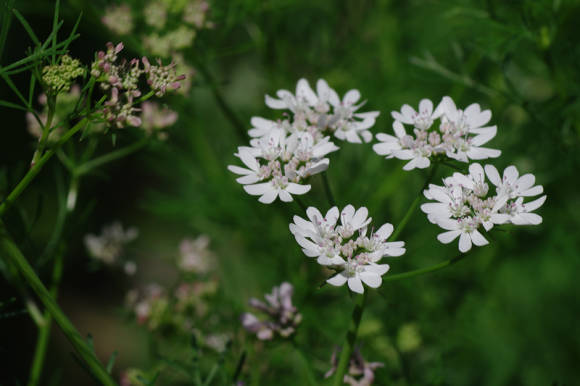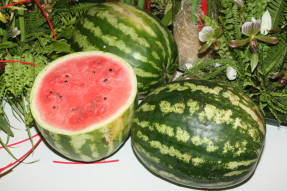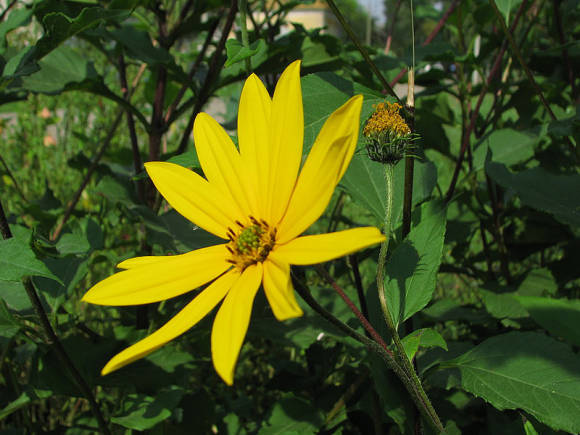 The fifth day of our English journey began and ended with adventures in the train. Arriving at Victoria Station, we were a little confused by its size, the complexity of the schedule and the rules for surcharging a city ticket. After spending an hour on the platform, the next hour we enjoyed looking at suburban and suburban London, familiar landscapes - after all, Hampton Court, like Kew, is located on the Thames in the Richmond area, above and east of the capital.
The fifth day of our English journey began and ended with adventures in the train. Arriving at Victoria Station, we were a little confused by its size, the complexity of the schedule and the rules for surcharging a city ticket. After spending an hour on the platform, the next hour we enjoyed looking at suburban and suburban London, familiar landscapes - after all, Hampton Court, like Kew, is located on the Thames in the Richmond area, above and east of the capital.  |  |
 |  |
As you approach the palace, attention is drawn to the long red service building, especially the modern gates of the Clore Education Center, entwined with golden trees. Nearby there is an extensive ticket office - fortunately, no queues - and a bookstore, where we easily found two guidebooks in Russian and one English book about the park. And then they came to the gate - it's hard to say whether it was a palace or a castle.
 |  |  |
 |  |
A beautiful estate on the banks of the Thames, in a place inhabited by the ancient Romans, once belonged to the Hospitaller Order, known to us as the Maltese. From them the estate was taken over by Cardinal Thomas Woolsey, a kind of "Cardinal Richelieu" under Henry VIII.
 |  |
 |  |
 |  |  |
William III is a man with a stormy and victorious biography. Brought up in his native Holland by his English relatives, after difficult military vicissitudes, he won Britain from his uncle, the Catholic King James II. His position as the husband of the Queen of England encouraged demonstrative actions and projects. By that time, the luxurious and unprecedented for Holland palace complex Het Loo in the city of Apeldoorn had already been completed. There, the French scheme of the parterre garden and the façade of the palace was applied to local conditions, the garden is surrounded by the "trademark" Dutch earthen rampart, statues and fountains coexisted with flowering plants of different shapes. I have been to Het Loo more than once and have the opportunity to show several comparative pairs of photographs - they speak better than long explanations.
Two Willem-William Gardens: Hat Loo and Hampton Court
 |  |
 |  |
 |  |
 |  |
 |  |
 |  |
 |  |
 |  |
 |  |
 |  |
 |  |
Here fish were bred and kept for the royal table, and the slopes of the coast were decorated with beautiful ledges. Behind them, over the waters of the Thames, stands the Dining House, from the windows of which, in the Tudor era, also opened a view of the Royal Aviary.
 |  |


In the largest, adjacent to the King's Own Garden, cut flowers were grown.
The second had not only decorative, but also heraldic significance - a collection of citrus fruits was exhibited there in the summer, among which orange trees, a symbol of the Orange dynasty, played the main role.
The third was called the Garden of Primroses, but among them grew a great variety of bulbs, especially tulips and anemones - here again you can see the Dutch taste. And finally, in the smallest Greenhouse garden there were three "glass houses" - greenhouses with a magnificent collection of exotic plants. In both the Dutch and English periods of their reign, William and Mary spared no effort or expense in replenishing it.
 |  |
This place got its modern look in the 1920s, when the gardener and historian Ernst Lowe was the keeper of the Hampton Court Park. He prepared a project to recreate the ponds of Henry VIII, which was not carried out, and laid out at the castle walls a "nodal", that is, decorated with intersections of curb strips, a Tudor-style garden.
 |  |
 |  |
 |  |  |
Nearby hangs a Guinness Book certificate stating that it is not only the oldest, but also the largest vine in the world, whose twists are more than 75 meters. Until the 1920s, the bunches were served exclusively at the royal table, but now in season they can be bought at the palace store.
 |  |
 |  |  |
 |  |
 |  |
 |  |
 |  |  |
The garden was completed already in the era of William and Mary, who brought the interesting and talented architect Daniel Maro with them from Holland. Coming from a French architectural family, he perfectly understood the style and forms of the era of Louis XIV. His family was Huguenot, so he was forced to leave his homeland and began to work at the court of the Dutch stadtholder Willem. It was he who created the relatively modest and closed parterre garden in Het Loo. At Hampton Court, he expands the scale of his projects: the Dutch intimacy is replaced by the French scale.
 |  |
Since 1764, Lancelot Brown became the chief gardener of Hampton Court. The great master of landscape gardening was forced to somehow maintain the existence of regular gardens, which no longer enjoyed the attention of the English monarchs. He canceled the shearing of the pyramid trees of the Fountain Garden, and they gradually turned into gigantic yews and holly, covering the horizon.
 |  |
In the 19th century, large flower borders were created along the wall separating the Own Garden, and tulips and asters were planted right on the former parterres of the Fountain Garden - there were held spring and summer flower exhibitions. Now the garden has been returned to its original form.
But two traces remain from the "walking" era. The first is a beautiful, spectacular curb along the Broad Alley, created by the already mentioned Ernst Lowe, a gardener of the 1920s. The second is the outlandish trees of the Fountain Garden.
 |  |
Having got used to the vastness of Versailles, we decided to walk into the distance, along the canal. But it was not there! Around the lattice, and behind it, as in St. James and Chiswick - geese-swans and their sleepy kingdom.
 |  |
There are several gardens to the left of the palace. An old, but luxurious rose garden with "old English" varieties of roses, a landscape lawn and finally - the famous Labyrinth! Now there is an open space around it, but, apparently, this is the last piece of the Wild Garden, once huge, full of baroque green curtains and winding alleys.
 |  |

 Unlike Harris, I have a great respect for garden labyrinths. And in the French Villandry, and in the Venetian villa of Pisani, they tenaciously hold in their arms dozens of adults, intelligent people. In Villa Pisani, the caretaker climbed the tower at the heart of the labyrinth and shouted into the megaphone: "To the right! To the left!" In a scene created by an English writer, Hampton Court's caretaker tried to do the same with a folding ladder.
Unlike Harris, I have a great respect for garden labyrinths. And in the French Villandry, and in the Venetian villa of Pisani, they tenaciously hold in their arms dozens of adults, intelligent people. In Villa Pisani, the caretaker climbed the tower at the heart of the labyrinth and shouted into the megaphone: "To the right! To the left!" In a scene created by an English writer, Hampton Court's caretaker tried to do the same with a folding ladder.  |  |
“We’ll only stop by for a little while so you can say that you’ve been in the labyrinth, but it’s not difficult at all. It's even ridiculous to call it a labyrinth. You have to turn right all the time. We walk for about ten minutes, and then we'll go to breakfast.
Once inside the labyrinth, they soon met people who said that they were here for three quarters of an hour and that they seemed to have had enough. Harris invited them, if you like, to follow him. He just entered, now he will turn right and exit. Everyone was very grateful to him and followed him. On the way, they picked up many more who dreamed of getting out into the wild, and finally absorbed everyone who was in the maze. The people who had given up all hope of seeing their home and friends again, at the sight of Harris and his company, perked up and joined the procession, showering him with blessings. Harris said that, according to his assumption, “in general, about twenty people followed him; one woman with a child, who had been in the maze all morning, certainly wished to take Harris by the arm, so as not to lose him.
Harris kept turning to the right, but it was evidently a long way to go, and a relative of Harris said that it was probably a very large labyrinth.
“One of the largest in Europe,” said Harris.
“It seems so,” his relative replied. - We've already passed
a good two miles.
This began to seem strange to Harris himself. But he held on steadfastly until the company passed by the half of the donut lying on the ground, which a relative of Harris's, according to him, had seen in this very place seven minutes ago.
“It’s impossible,” said Harris, but the woman with the child said:
“Nothing of the kind,” since she herself took this donut from her boy and threw it away before meeting Harris. She added that it would be better for her never to meet with him, and expressed the opinion that he was a deceiver. This infuriated Harris. He drew out a plan and laid out his theory.
- The plan may not be bad, - someone said, - but you just need
know where we are now.
Harris did not know this and said that the best thing would be to go back to the exit and start over. The proposal to start all over again did not generate much enthusiasm, but there was complete unanimity about going back. They all turned back and followed Harris in the opposite direction.
 |  |
Three minutes later they were back in the center.
After that, they simply could not leave. Whichever way they turned, all the paths brought them to the center. It began to repeat itself with such regularity that some simply stayed in place and waited for the rest to walk and return to them. Harris again drew up his plan, but the sight of this paper infuriated the crowd. Harris was advised to start the plan for the papillotes. Harris, he said, could not help but realize that he had lost some of his popularity.
Finally, everyone completely lost their heads and began to call loudly watchman. The watchman came, climbed a ladder outside the labyrinth, and began giving them directions loudly. But by this time, everyone was in such a confusion in their heads that no one could figure anything out. Then the watchman invited them to stand still and said that he would come to them. Everyone gathered in a heap and waited, and the watchman descended the stairs and went inside. On the mountain, he was a young watchman, a beginner in his business. Entering the labyrinth, he did not find those who were lost, began to wander back and forth, and finally got lost himself.From time to time they saw through the foliage how he rushed somewhere on the other side of the fence, and he also saw people and rushed to them, and they stood and waited for him for five minutes, and then he again appeared in the same place and asked where they disappeared.
Everyone had to wait until one of the old watchmen, who had gone to dinner, returned. Only then did they finally come out.
Harris said that, since he could judge, it was a wonderful maze, and we agreed that we would try to get George there on the way back.
Jerome K. Jerome. Three in the same boat, not counting the dog (1889). Translated by M. Salier

At the beginning of the 18th century, Hampton Court became the scene of royal quarrels, and the rival courts of fathers and children soon reduced the prestige of the residence to nothing. Gradually, it turned into the abode of minor princes and princesses, and then maids of honor, living out their days in the small rooms of the great palace. In 1986, one of them knocked down a fire in her room, setting off a huge fire in the state chambers of William III.
In 1838, Queen Victoria opened the park to the public, and ten years later a special branch of the railway was built here. The motley public flocked to Hampton Court, which the newspapers began to call "London Garden". Several generations of Londoners have grown up on Sunday walks in the overgrown park with its flower beds and ancient statues. It was only in the twentieth century that a balance was found between half-wild rest and immersion in history.
 |  |

Although the Crown owns the residence, it is run by the Historical Royal Palaces, a non-profit organization, along with the Tower and Kensington Palace. It has built a powerful cultural tourism industry - a large entrance fee and unlimited options for staying in the palace, including audio guides and photography.
 |  |
 It populated the palace with dozens of people in Tudor outfits, graceful ladies in velvet dresses lead children on excursions, and you can ride a cart pulled by heavy horses in the park. An iron harrow stretches behind the cart - you need to level the alleys, dotted with thousands of footprints!
It populated the palace with dozens of people in Tudor outfits, graceful ladies in velvet dresses lead children on excursions, and you can ride a cart pulled by heavy horses in the park. An iron harrow stretches behind the cart - you need to level the alleys, dotted with thousands of footprints!  In the story "Three in a Boat" I found cute lines that are full of life today:
In the story "Three in a Boat" I found cute lines that are full of life today: What a wonderful old wall stretches along the river in this place! Passing her, I always feel pleasure from the sight of her. Bright, sweet, cheerful old wall! How wonderfully decorate it with lichen creeping and wildly growing moss, a bashful young vine peeking out from above to see what is happening on the river, and dark old ivy curling a little lower. Any ten yards of this wall reveals fifty nuances and shades to the eye. If I could paint and paint, I would probably create a beautiful sketch of this old wall. I often think I would love to live in Hampton Court.
The most vivid impression of Hampton Court is bright, spectacular antiquity, quaint towers, wonderful tapestries, energetic, fresh Baroque gardens with hissing streams of water, swans on the sleepy Long Canal. And gray mosses on the red, rainy and windy walls, and behind them are the thin trunks and malachite crowns of orange trees.










